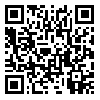Volume 11, Issue 1 (Spring 2009)
Advances in Cognitive Sciences 2009, 11(1): 56-67 |
Back to browse issues page
Abstract: (3130 Views)
Objective: Several models state that attention in social phobia is directed towards threatening social stimuli (Clark and Wells, 1995). Clark and Wells (1995) also propose that people with social phobia may avoid attending to social situations as well, which could in itself cause the continuation of anxiety. To solve this contradiction the vigilance-avoidance hypothesis (Mogg et al., 1997) suggests that hypervigilance is followed by avoidance of the threat stimulus, which serves as a defensive function. The present study compares attentional bias (toward angry and happy faces, as well as objects), in clinically social phobic and normal controls.
Method: Eight patients with social phobia were selected from the clients of Shiraz University clinic using clinical interview and social anxiety inventory. These groups were matched according to age, gender and education variable with 12 normal subjects. Participants responded to the visual probe task using pictures of real faces. Mixed repeated measures and LSD post-hoc test were used to analyze the data.
Results: The analysis shows that in comparison with normal controls, socially phobic patients avoid threatening facial expressions.
Method: Eight patients with social phobia were selected from the clients of Shiraz University clinic using clinical interview and social anxiety inventory. These groups were matched according to age, gender and education variable with 12 normal subjects. Participants responded to the visual probe task using pictures of real faces. Mixed repeated measures and LSD post-hoc test were used to analyze the data.
Results: The analysis shows that in comparison with normal controls, socially phobic patients avoid threatening facial expressions.
Type of Study: Research |
Subject:
Special
Received: 2008/11/21 | Accepted: 2009/01/20 | Published: 2009/03/21
Received: 2008/11/21 | Accepted: 2009/01/20 | Published: 2009/03/21
| Rights and permissions | |
 |
This work is licensed under a Creative Commons Attribution-NonCommercial 4.0 International License. |


